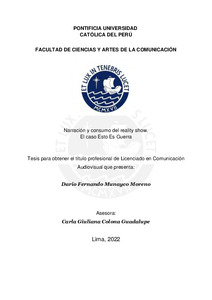| dc.contributor.advisor | Colona Guadalupe, Carla Giuliana | |
| dc.contributor.author | Munayco Moreno, Dario Fernando | |
| dc.date.accessioned | 2022-10-17T17:17:55Z | |
| dc.date.available | 2022-10-17T17:17:55Z | |
| dc.date.created | 2022 | |
| dc.date.issued | 2022-10-17 | |
| dc.identifier.uri | http://hdl.handle.net/20.500.12404/23584 | |
| dc.description.abstract | En este estudio se desarrolla un análisis de la estructura narrativa del programa de
televisión, de formato reality show, “Esto es Guerra” y su relación con los hábitos de consumo
de dos grupos de personas que hacen parte de la audiencia que viven en el distrito de
Independencia, Lima. Se pone énfasis en las prácticas sociales de comunicación y en el
consumo de televisión por parte de jóvenes hombres entre 20 y 27 años de edad, solteros y sin
hijos; y en madres de familia de estado civil diverso entre los 20 y 35 años de edad.
Se realiza observación del proceso de consumo televisivo en un espacio privado
(vivienda de jóvenes varones) y en un espacio público (área de juegos del mercado FEVACEL).
Además, se incluye un análisis del programa televisivo “Esto es Guerra” entre los años 2012 al
2014, cuando se emite a nivel nacional por el canal de televisión América TV de Lima.
Entre los principales hallazgos están la caracterización de la relación que existe entre el
lenguaje audiovisual utilizado en “Esto es Guerra” (EEG) y la forma de consumo de los grupos
observados. Resalta la capacidad narrativa del medio y su consecuente efecto en la construcción
del sentido de realidad (una realidad televisiva) así como su capacidad para expandirse y
reproducirse en otras plataformas.
Se verifica que el sensacionalismo se manifiesta a través de personajes y discursos
populares ordenados en una estructura narrativa diseñada para generar controversia en un marco
de espectacularidad. El análisis permite establecer una lista de claves del código sensacionalista
de la televisión peruana. Estos van desde el lenguaje audiovisual (planos, movimientos de
cámara, musicalización e iluminación) hasta la formación de realidad ficcional construida por
discursos y estructuras narrativas que definen la figura del cuerpo, del hombre, de la mujer, el
amor, el romanticismo, la amistad y la sexualidad (vida privada) de los personajes.
En ese sentido, el consumo se organiza en el marco de la “cultura del chisme”, la cual
parte de historias mediatizadas dedicadas al escrutinio de la vida privada de los personajes
televisivos. Estas historias mediatizadas se configuran como discursos que validan la
exposición y el comercio de conflictos entre personajes mediáticos a través de distintas
plataformas. | es_ES |
| dc.description.abstract | This study develops an analysis of the narrative structure of the television program,
reality show format, "Esto es Guerra" and its relationship with the consumption habits of two
groups of people who are part of the audience who live in Independencia district, Lima.
Emphasis is placed on social communication practices and television consumption by young
men between 20 and 27 years of age, single and without children; and in mothers of diverse
marital status between 20 and 35 years of age.
Observation of the television consumption process is carried out in a private space
(housing for young men) and in a public space (game area of the FEVACEL market). In
addition, an analysis of the television program “Esto es Guerra" is included between 2012 and
2014, when it is broadcast nationally by the television channel América TV in Lima.
Among the main findings is the characterization of the relationship between the
audiovisual language used in "Esto es Guerra" (EEG) and the form of consumption of the
groups observed. It highlights the narrative capacity of the medium and its consequent effect
on the construction of the sense of reality (a television reality) as well as its capacity to expand
and reproduce itself on other platforms.
It is verified that sensationalism is manifested through popular characters and speeches
ordered in a narrative structure designed to generate controversy in a spectacular setting. The
analysis allows to establish a list of keys of the sensationalist code of the Peruvian television.
These range from audiovisual language (shots, camera movements, music and lighting) to the
formation of fictional reality constructed by discourses and narrative structures that define the
figure of the body, man, woman, love, romanticism, friendship and sexuality (private life) of
the characters.
In this sense, consumption is organized within the framework of the "culture of gossip",
which starts from mediated stories dedicated to the scrutiny of the private lives of television
personalities. These mediated stories are configured as discourses that validate the exposure
and trade of conflicts between media characters through different platforms. | es_ES |
| dc.language.iso | spa | es_ES |
| dc.publisher | Pontificia Universidad Católica del Perú | es_ES |
| dc.rights | info:eu-repo/semantics/openAccess | es_ES |
| dc.rights.uri | http://creativecommons.org/licenses/by/2.5/pe/ | * |
| dc.subject | Reality shows (Programas de televisión) | es_ES |
| dc.subject | Programas de televisión--Investigación | es_ES |
| dc.subject | Televisión | es_ES |
| dc.subject | Comunicación audiovisual | es_ES |
| dc.subject | Chisme--Medios audiovisuales | es_ES |
| dc.title | Narración y consumo del reality show. El caso Esto Es Guerra | es_ES |
| dc.type | info:eu-repo/semantics/bachelorThesis | es_ES |
| thesis.degree.name | Licenciado en Comunicación Audiovisual | es_ES |
| thesis.degree.level | Título Profesional | es_ES |
| thesis.degree.grantor | Pontificia Universidad Católica del Perú. Facultad de Ciencias y Artes de la Comunicación. | es_ES |
| thesis.degree.discipline | Comunicación Audiovisual | es_ES |
| renati.advisor.dni | 06408563 | |
| renati.advisor.orcid | https://orcid.org/0000-0003-0702-2854 | es_ES |
| renati.author.dni | 44306036 | |
| renati.discipline | 211086 | es_ES |
| renati.juror | Vasquez Fermi, Guillermo | es_ES |
| renati.juror | Colona Guadalupe, Carla Giuliana | es_ES |
| renati.juror | Valdivieso Payva, Jorge James | es_ES |
| renati.level | https://purl.org/pe-repo/renati/level#tituloProfesional | es_ES |
| renati.type | https://purl.org/pe-repo/renati/type#tesis | es_ES |
| dc.publisher.country | PE | es_ES |
| dc.subject.ocde | https://purl.org/pe-repo/ocde/ford#5.08.00 | es_ES |






